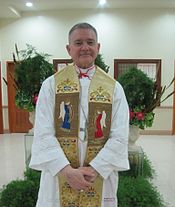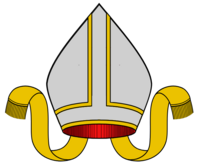The Roman Catholic Diocese of Retimo Latin: Dioecesis Rhithymnensis) was a Roman Catholic diocese located in the town of Rethymo on the north coast of the island of Crete. It was established around 1250 AD. On 5 November 1551, it was renamed as Diocese of Retimo–Ario (Italian) / Rhithymnensis–Ariensis (Latin) and gained territory from the suppressed Roman Catholic Diocese of Ario.

The Archdiocese of Amalfi-Cava de' Tirreni is an archdiocese of the Latin Church of the Catholic Church, with its episcopal see at Amalfi, not far from Naples. It was named Archdiocese of Amalfi until parts of the Diocese of Cava e Sarno were merged with it on September 30, 1986.

The Archdiocese of Reggio Calabria-Bova is a Latin Church ecclesiastical territory or diocese of the Catholic Church in Calabria, southern Italy. It received its current title in 1986, when the independent Diocese of Bova was suppressed, and the territory and title of the diocese added to that of the Archdiocese of Reggio.

The Roman Catholic Archdiocese of Coro is a Latin metropolitan archdiocese in western Venezuela.
The Diocese of Montemarano was a Roman Catholic diocese located in the town of Montemarano in the province of Avellino in the Campania region of southern Italy. It was erected in 1059, and was a member of the ecclesiastical province of Benevento. In 1818, the diocese was suppressed, and its territory and Catholic population was assigned to the Diocese of Nusco. The diocese of Nusco has been absorbed, since 30 September 1986, into the agglomerate Archdiocese of Sant'Angelo dei Lombardi-Conza-Nusco-Bisaccia.
The Diocese of Castro di Puglia was a Roman Catholic diocese located in the town of Castro of Lecce in the Apulia region of south-eastern Italy. In 1818, it was suppressed to the Archdiocese of Otranto. In 1968, it was restored as the titular see of Castro and then in 1976, as the titular see of Castro di Puglia.
The Roman Catholic Diocese of Alessano was a Roman Catholic diocese in Italy, located in the city of Alessano, in the province of Lecce, part of Apulia region of south-east Italy. On 28 June 1818, it was suppressed to the Diocese of Ugento.
The Diocese of Isola was a Roman Catholic diocese in Italy, located in Isola di Capo Rizzuto, Crotone, Reggio Calabria in the ecclesiastical province of Santa Severina.
The Diocese of Minori was a Roman Catholic diocese in Italy, located in Minori, province of Salerno, region of Campania in the ecclesiastical province of Amalfi. In 1815, it was suppressed, and its territory and Catholic population assigned to the Archdiocese of Amalfi.
The Roman Catholic Diocese of Capri was a Roman Catholic diocese located in the city of Capri on the island of Capri, in the Tyrrhenian Sea off the Sorrentine Peninsula, on the south side of the Gulf of Naples in the Campania region of Italy. On 27 June 1818, it was suppressed to the Archdiocese of Sorrento.
Giovanni Agostino Campanile was a Roman Catholic prelate who served as Bishop of Minori (1567–1594).
The Roman Catholic Diocese of Lettere-Gragnano was a Latin Catholic diocese located in the commune of Lettere in the Metropolitan City of Naples in the southern-central Italian region Campania. In 1818, it was merged into the Diocese of Castellammare di Stabia.
Giovanni Bernardino Grandopoli was a Roman Catholic prelate who served as Bishop of Lettere-Gragnano (1576–1590).
Francesco D'Afflitto was a Roman Catholic prelate who served as Bishop of Scala (1583–1593). He descends from the princely house d’Afflitto.

The Diocese of Mottola or Diocese of Motula was a Roman Catholic diocese located in the town of Mottola in the province of Taranto in the region of Apulia in southeast Italy. In 1818, it was suppressed to the Diocese of Castellaneta.
The Diocese of Ravello e Scala was a Roman Catholic diocese located in the town of Ravello on the Amalfi Coast in the province of Salerno, Campania, southern Italy. In 1818, it was suppressed.
The Diocese of Cephalonia and Zakynthos was Roman Catholic diocese located on the Ionian Island of Cephalonia. It was suppressed in 1919.

Gaspare Ricciullo del Fosso, O.M. (1496–1592) was a Roman Catholic prelate who served as Archbishop of Reggio Calabria (1560–1592), Bishop of Calvi Risorta (1551–1560), and Bishop of Scala (1548–1551).
Paolo De Curtis, C.R. was a Roman Catholic prelate who served as Bishop of Isernia (1600–1606) and Bishop of Ravello (1591–1600).
Carlo Montigli was a Roman Catholic prelate who served as Archbishop of Viterbo e Tuscania (1576–1594), Apostolic Nuncio to Florence (1591–1592), and Archbishop of Amalfi (1570–1576).









